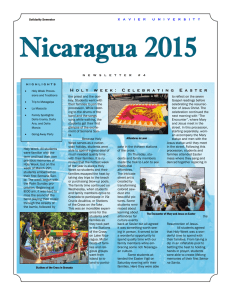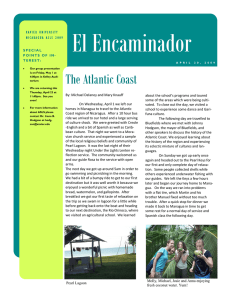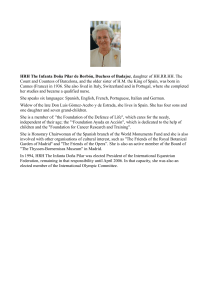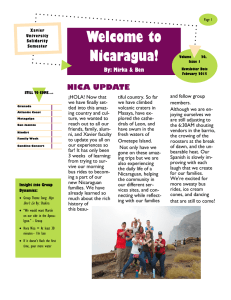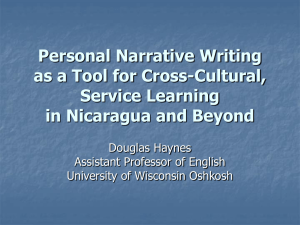NICARAGUA 2015 Visitors’ Week!
advertisement
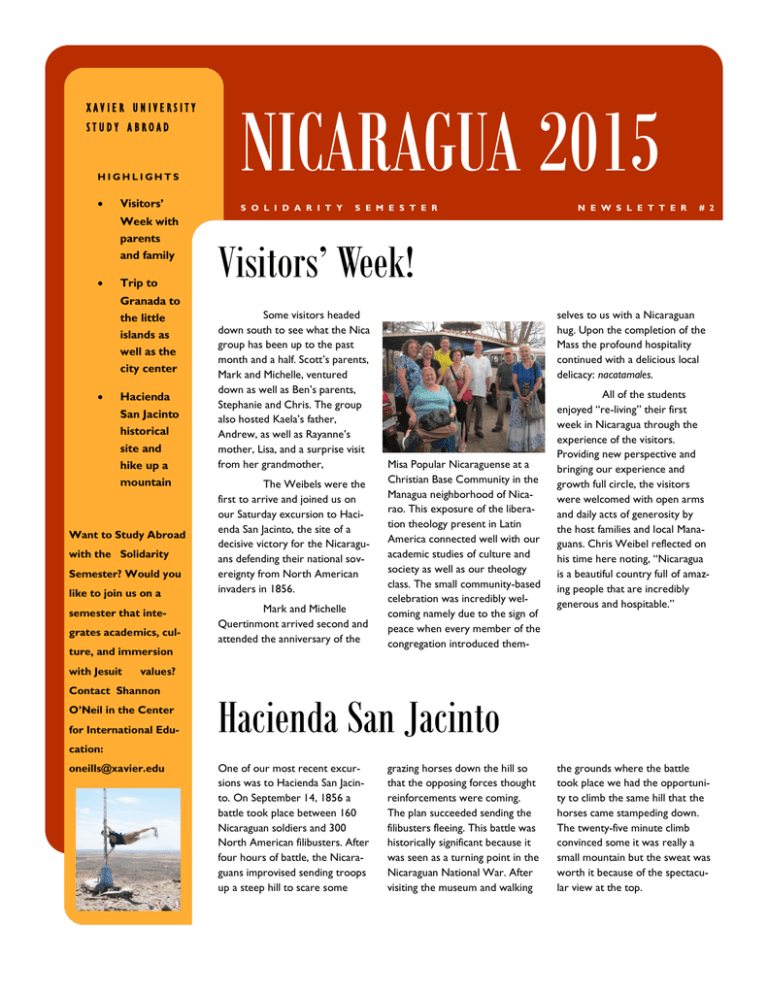
XAVIER UNIVERSITY STUDY ABROAD HIGHLIGHTS Visitors’ Week with parents and family Trip to Granada to the little islands as well as the city center Hacienda San Jacinto historical site and hike up a mountain Want to Study Abroad with the Solidarity Semester? Would you like to join us on a semester that integrates academics, cul- NICARAGUA 2015 S O L I D A R I T Y S E M E S T E R # 2 Visitors’ Week! Some visitors headed down south to see what the Nica group has been up to the past month and a half. Scott’s parents, Mark and Michelle, ventured down as well as Ben’s parents, Stephanie and Chris. The group also hosted Kaela’s father, Andrew, as well as Rayanne’s mother, Lisa, and a surprise visit from her grandmother, The Weibels were the first to arrive and joined us on our Saturday excursion to Hacienda San Jacinto, the site of a decisive victory for the Nicaraguans defending their national sovereignty from North American invaders in 1856. Mark and Michelle Quertinmont arrived second and attended the anniversary of the ture, and immersion with Jesuit N E W S L E T T E R selves to us with a Nicaraguan hug. Upon the completion of the Mass the profound hospitality continued with a delicious local delicacy: nacatamales. Misa Popular Nicaraguense at a Christian Base Community in the Managua neighborhood of Nicarao. This exposure of the liberation theology present in Latin America connected well with our academic studies of culture and society as well as our theology class. The small community-based celebration was incredibly welcoming namely due to the sign of peace when every member of the congregation introduced them- All of the students enjoyed “re-living” their first week in Nicaragua through the experience of the visitors. Providing new perspective and bringing our experience and growth full circle, the visitors were welcomed with open arms and daily acts of generosity by the host families and local Managuans. Chris Weibel reflected on his time here noting, “Nicaragua is a beautiful country full of amazing people that are incredibly generous and hospitable.” values? Contact Shannon O’Neil in the Center for International Edu- Hacienda San Jacinto cation: oneills@xavier.edu One of our most recent excursions was to Hacienda San Jacinto. On September 14, 1856 a battle took place between 160 Nicaraguan soldiers and 300 North American filibusters. After four hours of battle, the Nicaraguans improvised sending troops up a steep hill to scare some grazing horses down the hill so that the opposing forces thought reinforcements were coming. The plan succeeded sending the filibusters fleeing. This battle was historically significant because it was seen as a turning point in the Nicaraguan National War. After visiting the museum and walking the grounds where the battle took place we had the opportunity to climb the same hill that the horses came stampeding down. The twenty-five minute climb convinced some it was really a small mountain but the sweat was worth it because of the spectacular view at the top. P AGE 2 Service Placement: Pajarito Azul Nestled in a suburb of Managua, the little campus of Pajarito Azul provides a necessary and important service in Nicaraguan society. In the 1980s and 90s the government saw an overwhelming need to provide a safe place for men, women, and children with special needs. Thus, Pajarito Azul was created. Pajarito provides a home to orphaned children and adults with developmental and physical disabilities, Pajarito is the service placement for our students Dajah Siplin and Kaela Allton. Our volunteers there spend time with the residents, making crafts, playing games, and ,on Wednesdays, they dance during music therapy! Kaela works with the older women; talking with them, pushing them on the swings, and making sure the residents get their daily exercise by walking around the campus with them. Dajah works with the children at Pajarito, specifically the ones with cerebral palsy. She says, “It’s an indescribable feeling, working with them. Over the past month or so I have learned what makes them laugh, cry, what they like to be fed and so many other things. Going to Pajarito Mondays through Wednesdays is honestly the best part of my week. They have quickly become very important to me.” Kaela also enjoys her time at Pajarito, saying, “The residents there as so full of life, love, and energy. They are constantly teaching me about what it means to truly live.” Mejorando Nuestro Español “Now that’s Liberation Theology!” everyone in the group at some point in the trip On the academic end, our Spanish classes are doing wonders for our language skills as our communication with our host families has improved immensely. Being immersed 24/7, taking the bus daily, reading the paper, and eating with Nicaraguans has taught us about the daily reality and struggle of life here. Our Spanish professors, Doña Myrna and Doña Ana, are dedicated and patient teachers who constantly challenge us—which yields tremendous results. Each of the eight of us are in pairs for Spanish class. The 2:1 student to teacher ratio provides a unique and personal learning experience which accelerates our learning and improvement. Our skills are put to the test during our excursions and our charlas, or talks with local leaders and prominent figures. Doña Myrna has been with the program almost since the beginning. She is usually accompanied by her brother. However this year Doña Ana is our other teacher. Both have worked together for many years teaching English to foreigners, most notably Japanese students studying in Nicaragua. Culture: Luis Enrique Mejía Godoy One Friday night we had the privilege of attending an important cultural event, the concert for the anniversary of the death of national hero, Augusto Sandino. The famous singer/songwriter Luis Enrique Mejia Godoy sang many songs NICA RAGUA 2015 of national pride, and we students had the honor to bring our host mothers to this concert to which they looked forward with great excitement. We had heard many of these songs of nationalism and heroism in our culture and society class but seeing our mothers who lived through a decisive revolutionary period sing along with the songs with much enthusiasm and passion brought our history class alive in front of our eyes. Ruta Maya, a restaurant/small concert venue, was the home of the concert. Thanks to Martin who called ahead for the reservation of 30, we were able to have front row seats. SOLIDA RIT Y SEMESTER P AGE Excursion: Granada Our expedition to Granada was jam-packed full of academic enhancements at the museums and cultural tour of the Spanish colonial city and a little recreation at Las Isletas, some natural volcanic islands in Lake Nicaragua where we observed the natural beauty and swam in the serene freshwater lake. Granada, the historic home of the Nicaraguan conservatives, is full of historic colonial and neocolonialism architecture. The beautiful city is home to historic mansions, majestic churches, and some great restau- rants for some authentic Nicaraguan cuisine. Our guide for the day Ana Rosa works for the Granada archives and seemed to know everyone in town which gave us the unique opportunity to see places and sites that ordinary Americans do not have the opportunity to see. For example, we visited the former home of William Walker, a North American filibuster of the 1850s who declared himself president of Nicaragua. The mansion was quite elegant and is now owned by the wealthiest family in Nicaragua. The afternoon trip to the islands and an afternoon swim with the volcano Mombacho in the distance provided a beautiful backdrop. Casa Benjamin Linder: Free Trade Zones Every week the group goes to the Casa Ben Linder, an ecumenical gathering place named for an American volunteer killed in the Contra War. Every Thursday Nicaraguans and foreigners alike gather to hear a guest talk about a social issue. Most recently the topic was free trade zones. We hear back home about these but never have the opportunity to meet the workers. A worker told her story and the conditions in which she works. Her work day begins at 7 AM and ends at 7 PM (the legal work day is 8 AM—5 PM). She spoke of her health related injuries due to poor working conditions which force her to take sick days. The result in lost pay puts more strain on her family economically. The eye-opening conversation challenged us to think more about where our clothes are manufactured. Natural Beauty During this first month and a half in Nicaragua, the group has had many great opportunities to experience the truly breathtaking nature Nicaragua offers. We have seen five of the eight active volcanoes in Nicaragua and have even gotten to climb one of the them. We explored caves, swam in lakes and lagoons, and hiked in natural reserves. The extensive flora and fauna, for example, native monkeys and snakes have surprised some and lefts others a little uncomfortable with the up-close encounter with the native animals. Even though we have been here during the dry season when some trees shed their leaves due to lack of precipitation, there seems to be green everywhere you turn as well as beautiful natural water in the form of lakes, rivers, and lagoons. 3 Family Profile: Doña Coco If you are ever on your way to Hotel Ideas de Mamá you will pass by a green house with a dog sleeping on the porch and a small older women sitting and picking out good beans from bad ones. If you greet her by saying “Buenos días” she will most definitely greet you with an infectious smile. Her name is Doña Socorro but she is known as Doña Coco and host mother to Mirka Gallo. Doña Coco is mother to seven children, grandmother to 16 grandchildren, and greatgrandmother to 11 greatgrandchildren. If raising children and grandchildren were not enough, she also was a working mother, played an important role during the Revolution, was one of the founders of the Christian base community in Barrio La Luz, and has been a host mother with the Xavier program for over 15 years. Although she is retired, that has not slowed her down; she wakes up every morning at 4:50 to fill the barrels with water, do laundry, and make breakfast for five of her grandchildren who are going off to school. Her home is always open to any student or alumnus with a cold fresco waiting for them. You will never have an empty stomach or a dull moment in her home because you will be surrounded by a loving family and amazing food. Family Profile: Doña Nieves The always smiling and joyful Doña Nieves has been a strong figure in the history of both the Xavier program and in the history of the barrio. She runs the show during the community gatherings always making sure there is a program and that everyone is introduced. She is the host mother of Andrew Hermann. He says that “She has been so caring and wonderful each day always talking to me and making sure I am doing all right.” Nieves is known for her ability to talk for close to twenty minutes or more, depending on the day, which has been a challenge for Andrew’s Spanish. Doña Nieves is a great person from whom to learn Nicaraguan history since she has been living in the barrio since 1978. She lived through the revolution and was and still is very involved with the Catholic church. When the barrio had a Christian Base Community, Nieves served as one of the directors, coordinating the many tasks and duties that kept the faith community alive. She noted that it was a demanding task but incredibly rewarding. One of her favorite topics is religion and her unwavering faith keeps her going, she says. Andrew says she is the hardest worker he has ever seen. She only sits down to eat and to go to bed around 10:30 PM, only to get up around 5 AM to begin her work again. She is raising a grandchild, Marian (7) and runs the household for them and her husband, Erasmo. She also is an excellent seamstress. The house is a noisy one since four other people rent rooms in the house, and there are always stories to be shared and games to be played. A woman of devout faith and a strong sense of civic responsibility, Nieves is a great person with whom to have a cup of coffee and listen to some of her amazing stories.

